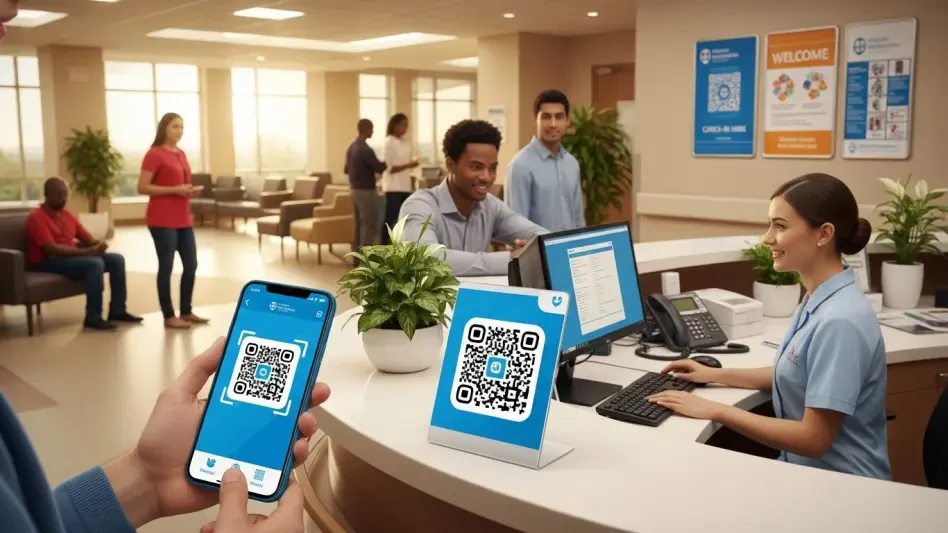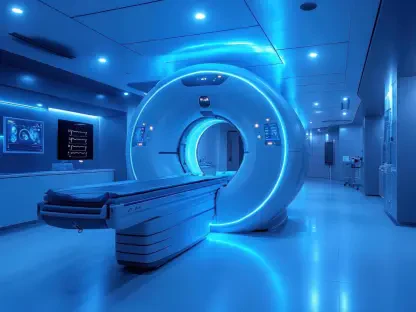Understanding the Phygital Revolution in Customer Experience
Imagine a world where a hospital visit feels as seamless and personalized as shopping at a favorite retail store, where technology and personal interaction blend effortlessly to enhance every step of the journey. This vision is at the heart of the phygital revolution, a concept that merges physical and digital interactions to create smooth, engaging customer experiences. Phygital strategies eliminate friction by integrating technology into real-world settings, ensuring that consumers can move effortlessly between online and offline touchpoints. In retail, this has meant innovations like mobile apps for in-store navigation or digital checkouts, fundamentally reshaping how brands connect with their audience.
The retail sector pioneered this approach, addressing pain points such as long wait times and impersonal service. Retail giants have set a high bar by using technology to anticipate customer needs, from scan-and-go features to tailored recommendations based on past purchases. These advancements have not only improved convenience but also built stronger emotional connections with consumers, proving that a hybrid model can transform satisfaction levels across industries.
Healthcare, much like retail, faces similar demands for convenience and engagement from patients who now expect more than just medical treatment. The relevance of phygital strategies in hospitals lies in their ability to streamline processes like check-ins or follow-ups while fostering a sense of care through personalized digital tools. By looking to innovators in retail, such as Sam’s Club with its efficient app-based solutions or CVS with integrated digital access points, hospitals can draw inspiration from established benchmarks in customer experience (CX) to elevate patient interactions to new heights.
Why Healthcare Needs Phygital Transformation
Emerging Trends in Patient Expectations
Today’s patients approach healthcare with a consumer mindset, seeking the same level of ease and customization they encounter when shopping online or in stores. This consumerization of healthcare reflects a broader shift where individuals expect quick access to services, transparent communication, and solutions tailored to their unique needs. Hospitals that fail to meet these evolving standards risk losing trust and engagement in an increasingly competitive landscape.
Another pivotal trend is the move toward value-based care, which prioritizes patient satisfaction and measurable outcomes over outdated fee-for-service models. This framework demands that providers focus on the entire patient journey, from initial contact to post-treatment care, ensuring every interaction adds value. Phygital approaches, such as digital appointment scheduling or real-time wait updates, can play a crucial role in meeting these goals by reducing stress and enhancing the overall experience.
Common pain points in healthcare, including lengthy delays in waiting rooms and disjointed communication between departments, can be directly addressed through these hybrid strategies. Digital tools can provide visibility into schedules, while integrated platforms ensure that critical information flows smoothly among caregivers. By adopting retail-inspired methods, hospitals have an opportunity to turn frustrating experiences into moments of efficiency and empathy.
Market Insights and Growth Potential
The demand for digital health solutions continues to surge, with a significant portion of patients already embracing tools like mobile apps for managing appointments and telehealth for remote consultations. Recent data indicates that over half of surveyed individuals use health-related applications, a trend that signals readiness for more sophisticated phygital integrations. This growing adoption underscores the potential for technology to become a cornerstone of patient engagement.
Looking ahead, projections suggest that phygital strategies could dramatically boost interaction rates and improve clinical outcomes by ensuring better adherence to treatment plans through timely digital reminders and personalized follow-ups. Hospitals that implement these systems stand to see not only happier patients but also more efficient operations, as streamlined processes reduce administrative burdens. From now to 2027, the market for such innovations is expected to expand rapidly, driven by technological advancements and patient demand.
Adopting retail-inspired approaches offers hospitals a competitive edge in a sector where differentiation is increasingly tied to experience rather than just expertise. Those who invest early in these strategies can position themselves as leaders, setting benchmarks for others to follow. The opportunity lies in leveraging digital transformation to create a healthcare environment that feels as responsive and intuitive as the best retail experiences.
Challenges in Implementing Phygital Strategies in Hospitals
Hospitals face significant hurdles when attempting to integrate phygital customer experience strategies, starting with outdated infrastructure that often cannot support modern digital tools. Many facilities still rely on legacy systems ill-equipped for seamless data sharing or real-time updates, creating a bottleneck for innovation. Overcoming this requires substantial investment in upgrades, a challenge for institutions already stretched thin on resources.
Technological barriers extend beyond hardware to include the need for interoperable software that can communicate across platforms while maintaining stringent security standards. Ensuring that patient data remains protected during digital interactions is paramount, yet integrating new systems with existing ones often proves complex. Hospitals must prioritize solutions that balance functionality with robust safeguards to avoid breaches that could erode trust.
Operational and cultural resistance further complicates adoption, as staff may be hesitant to embrace new workflows that disrupt familiar routines. Aligning teams around a patient-centric, tech-driven model demands comprehensive training and a shift in mindset at all levels. Phased implementation, partnerships with experienced technology providers, and ongoing education programs can help ease this transition, ensuring that both staff and patients feel confident in the evolving landscape.
Navigating the Regulatory and Security Landscape
The adoption of phygital strategies in healthcare must navigate a complex regulatory framework designed to protect patient privacy and ensure ethical use of technology. Laws such as HIPAA in the United States set strict guidelines on how personal health information can be stored, shared, and accessed, creating a non-negotiable boundary for digital initiatives. Compliance is not optional but a foundational requirement for any hospital looking to integrate hybrid experiences.
Security measures, including encryption and rigorous data governance protocols, are essential to safeguard sensitive information while enabling the benefits of digital tools. Hospitals must invest in systems that not only meet current standards but can adapt to evolving threats, maintaining patient confidence in the process. A breach or perceived lapse in protection can have devastating consequences, making this a critical area of focus for implementation teams.
Regulatory changes on the horizon could further shape the trajectory of digital transformation in healthcare, potentially easing certain restrictions or introducing new requirements. Staying ahead of these shifts demands proactive engagement with legal and policy developments, ensuring that phygital strategies remain agile. Hospitals that build trust through transparent security practices will be better positioned to leverage technology without compromising on compliance.
The Future of Phygital Healthcare Experiences
Envisioning the long-term impact of phygital strategies reveals a healthcare system where hospitals operate as smart, interconnected hubs with seamless patient journeys at their core. From digital check-ins that eliminate paperwork to real-time updates on treatment progress, the potential for technology to redefine care delivery is immense. Such advancements promise to make every interaction more intuitive, reducing friction at every step.
Emerging technologies, including AI-driven applications for personalized health insights, IoT solutions for in-hospital wayfinding, and deeper telehealth integration, stand poised to drive the next wave of phygital experiences. These tools can transform how patients navigate complex facilities or access care remotely, creating a more cohesive and responsive system. As these innovations mature, their adoption will likely accelerate, reshaping expectations once again.
Patient demand for tailored experiences and economic pressures on hospitals to optimize resources will act as powerful disruptors, pushing the sector toward faster innovation. Global trends, such as increasing smartphone penetration and aging populations, further amplify the need for scalable digital solutions. Economic conditions that prioritize cost-efficiency will also influence how quickly and broadly phygital strategies are embraced, making adaptability a key trait for future-focused institutions.
Key Takeaways and Recommendations for Hospitals
Phygital customer experience strategies, drawn from retail’s proven playbook, offer hospitals a transformative path to enhance patient satisfaction and clinical outcomes. By blending digital convenience with physical care settings, healthcare providers can address longstanding frustrations while building stronger connections with those they serve. The evidence is clear: integrating technology into the patient journey is no longer a luxury but a necessity for staying relevant.
Hospital leaders should prioritize investments in secure, scalable technology that supports seamless interactions, from appointment booking to post-visit care coordination. Fostering a patient-centric culture through staff training and change management is equally critical to ensure that digital tools are used effectively. Starting with pilot programs to test phygital initiatives can minimize risk, allowing for adjustments before full-scale rollout.
Reflecting on the insights shared, it is evident that the journey to phygital healthcare demands bold steps and strategic foresight. The path forward involves not just adopting new tools but reimagining how care can be delivered in a connected world. Hospitals that act decisively to partner with tech innovators, refine their operational models, and anticipate regulatory shifts will find themselves ahead, ready to shape a future where patient experiences rival the best of retail’s customer-centric achievements.









